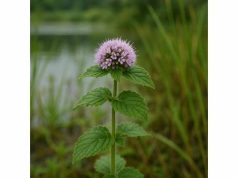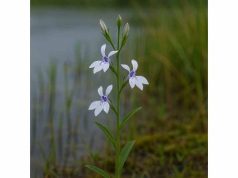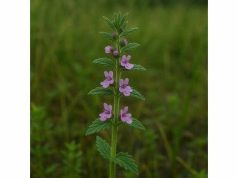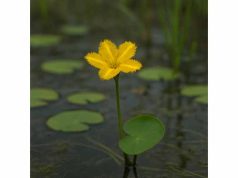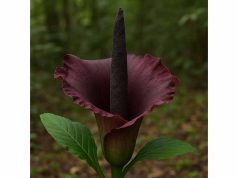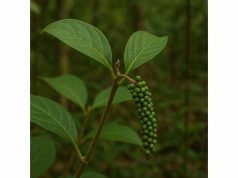
Virginia sage (Salvia virginica), a resilient perennial native to eastern woodlands and meadows, is prized not only for its fragrant, smoke‑gray foliage and spikes of violet‑blue blossoms but also for its rich spectrum of phytochemicals. Traditional herbalists have long brewed its leaves into restorative teas to ease digestive upset, support cognitive clarity, and soothe mild respiratory irritation. Modern analyses reveal potent concentrations of rosmarinic acid, essential oils like cineole and camphor, and flavonoids such as apigenin—compounds celebrated for anti‑inflammatory, antioxidant, and antimicrobial effects. Whether infused as a warming tea, distilled into essential oil, or incorporated into topical salves, Virginia sage offers versatile applications for holistic wellness enthusiasts.
Table of Contents
- Botanical Essentials and Identifying Features
- Phytochemical Highlights and Bioactive Molecules
- Core Health Advantages and Properties
- Application Methods and Safety Considerations
- Research Evidence and Key Findings
- Frequently Asked Questions
Botanical Essentials and Identifying Features
Virginia sage (Salvia virginica) belongs to the Lamiaceae, or mint family, renowned for square stems and aromatic foliage. This herbaceous perennial typically reaches 1.5–3 feet tall, featuring lanceolate leaves 1–3 inches long, arranged oppositely along softly hairy stems. Leaves exude a warm, camphor‑mint scent when crushed—a hallmark of Salvia species. In late spring to midsummer, the plant produces erect flower spikes bearing tubular, two‑lipped blossoms in shades of lavender to deep violet. Each blossom measures roughly an inch long and is accented by a contrasting white throat, attracting pollinators such as bees and hummingbirds.
The plant’s square, branching stems often take on a reddish tint as they mature. Beneath the surface, a shallow but spreading root system allows Virginia sage to colonize well‑drained soils in sunny glades, open woodlands, and prairie margins. Though adapted to moderate drought once established, young plants prefer consistent moisture and benefit from organic mulch to maintain root health. USDA hardiness zones range from 5 through 9, making it resilient to winter cold and summer heat.
Propagation occurs easily by seed or stem cuttings. Seeds sown in fall stratify naturally over winter, resulting in spring germination, while softwood cuttings taken in early summer root quickly in moist, sterile medium. Wildcrafting guidelines emphasize harvesting no more than one‑third of aerial growth per plant to preserve vigor and flowering potential. Cultivators appreciate Virginia sage not only for its herbal virtues but also for its ornamental value—flowers bloom over several weeks, and foliage retains fragrance even after blooms fade.
Gardeners often interplant with other native perennials such as Echinacea or Rudbeckia, creating pollinator‑friendly borders. The plant’s resilience to deer and rabbits, along with minimal pest issues, enhances its appeal. Observing Virginia sage in its natural habitat reveals ecological interactions: bees emerge early to collect nectar, while leaf‑cutting bees harvest foliage fragments for nest‑building. Understanding these botanical and ecological traits sets the foundation for sustainable use and cultivation.
Phytochemical Highlights and Bioactive Molecules
Virginia sage’s therapeutic potential stems from a rich phytochemical matrix. Key bioactives include:
- Rosmarinic Acid
A potent antioxidant and anti‑inflammatory phenolic compound, rosmarinic acid inhibits inflammatory enzymes like COX‑2 and supports free radical scavenging. It underlies much of the plant’s soothing effects on sore throats and skin irritations when applied topically or ingested as a tea. - Essential Oils (Cineole, Camphor, Thujone)
Steam‑distilled essential oil from dried leaves yields 1–3% yield, rich in cineole (eucalyptol) for respiratory support, camphor for mild analgesic action, and thujone, which stimulates circulation when used in aromatherapy. These volatile oils also contribute antimicrobial and insect‑repellent properties. - Flavonoids (Apigenin, Luteolin, Salvigenin)
Flavonoid glycosides impart antioxidant benefits and neuroprotective effects. Apigenin and luteolin cross the blood‑brain barrier to modulate GABAergic activity, promoting relaxation and mental clarity. Salvigenin—unique to some Salvia species—exhibits anti‑anxiety and anti‑seizure potential in preliminary studies. - Triterpenes (Ursolic Acid, Oleanolic Acid)
Located in leaf cuticles and cuticular waxes, these triterpenes deliver anti‑inflammatory and hepatoprotective benefits. Ursolic acid shows promise in muscle preservation and skin health, making sage extracts valuable in sports recovery formulas and skincare serums. - Phenolic Acids (Caffeic, Ferulic Acids)
Contributing to the overall antioxidant profile, these simple phenolics support immune modulation and protect against UV‑induced skin damage when applied topically in infused oils or balms. - Tannins
Moderately present in leaves, tannins lend astringent qualities that can help tone tissues and reduce minor bleeding. Sage gargles made from decoctions exploit this astringency to tighten mucous membranes in sore throats. - Coumarins
Trace levels of coumarin derivatives may contribute to mild anti‑coagulant effects, supporting healthy blood flow when consumed responsibly. - Vitamins and Minerals
Virginia sage also provides trace nutrients—vitamin A precursors, vitamin C, iron, and manganese—enhancing its role as a supportive herbal tonic for overall health.
The synergy among these constituents—termed the “entourage effect”—amplifies therapeutic outcomes. For instance, combining rosmarinic acid’s anti‑inflammatory action with essential oil’s antimicrobial properties yields broad‑spectrum relief in respiratory herbal formulas. When formulating extracts or teas, practitioners often standardize to a rosmarinic acid content of 2–4% to ensure consistency.
Core Health Advantages and Properties
Virginia sage offers a wide array of benefits, underpinned by its diverse phytochemistry:
- Anti‑Inflammatory Relief
Rosmarinic acid and triterpenes work together to soothe inflammatory pathways, helping ease joint stiffness, muscle soreness, and mild inflammatory skin conditions when used in teas, tinctures, or topical applications. - Antioxidant Protection
Flavonoids and phenolic acids neutralize free radicals, shielding cells from oxidative stress linked to aging, cardiovascular strain, and neurodegeneration. Regular inclusion of sage tea in one’s diet can complement dietary antioxidants like vitamin C. - Cognitive and Mood Support
Apigenin and salvigenin modulate neurotransmitter receptors, promoting mental clarity, focus, and a calm mood. A mid‑morning cup of sage infusion can sharpen concentration and reduce mental fatigue. - Respiratory Comfort
Cineole and camphor in essential oils act as expectorants and decongestants. Steam inhalation of sage‑infused water opens sinuses, relieves cough, and soothes bronchial passages during seasonal colds. - Digestive Aid
Bitter compounds stimulate digestive secretions, enhancing appetite and nutrient absorption. A post‑meal sage tea can alleviate bloating, gas, and indigestion without harsh side effects. - Hormonal Balance and Menstrual Ease
Phytoestrogenic flavonoids in sage help regulate estrogenic activity, potentially reducing heavy menstrual bleeding and alleviating hot flashes. Women’s health tonic blends often feature sage alongside chasteberry and red clover. - Antimicrobial and Antiviral Action
Essential oils and rosmarinic acid exhibit broad‑spectrum antimicrobial effects against bacteria like Streptococcus and viruses such as herpes simplex. Sage gargles and mouthwashes support oral health and reduce throat infections. - Skin‑Soothing and Healing
Ursolic acid and tannins tone skin, reduce redness, and support wound healing. Topical balsams or salves enriched with sage infusion moisturize and protect against minor irritations. - Blood Sugar Regulation
Emerging research suggests sage extracts improve insulin sensitivity and lower postprandial blood glucose spikes. Incorporating sage as a culinary herb or in standardized extracts may aid metabolic health. - Antispasmodic and Nervous System Support
Mild antispasmodic action alleviates menstrual cramps and digestive spasms. Combined with nervous‑system‑soothing herbs like skullcap, sage contributes to balanced nerve function.
By weaving these properties into personalized protocols—such as blending sage tea with ginger for digestive care or formulating inhalation steams for respiratory support—practitioners harness the herb’s multifaceted strengths.
Application Methods and Safety Considerations
Virginia sage’s versatility shines through in several preparation methods. Below are detailed guidelines and precautions:
1. Sage Tea (Infusion)
- Preparation: Steep 1 tablespoon of dried leaves in 8 oz boiling water for 10–15 minutes. Strain and enjoy hot or chilled.
- Dosage: 1–3 cups daily, between meals, to support digestion, cognition, and mild inflammation.
- Tip: Add lemon and honey for flavor and enhanced antioxidant synergy.
2. Tincture
- Preparation: Macerate fresh or dried leaves in 40–60% ethanol (1:5 weight/volume) for 3–6 weeks. Strain and bottle.
- Dosage: 20–30 drops in water, up to three times daily for acute relief of sore throat or digestive discomfort.
- Storage: Keep in amber dropper bottles, away from heat.
3. Essential Oil and Steam Inhalation
- Preparation: Steam‑distill dried leaves or purchase high‑quality Salvia virginica oil.
- Use: Add 3–5 drops to hot water; inhale steam under a towel to clear sinuses, ease cough, and refresh the mind.
- Safety: Avoid direct skin contact; perform patch test when used in topical blends.
4. Culinary Use
- Method: Chop fresh leaves and sprinkle over roasted vegetables, grains, or meats in the last 5 minutes of cooking.
- Benefit: Delivers savory aroma, digestive support, and antioxidant boost.
5. Topical Salve or Balm
- Preparation: Infuse dried leaves in olive or coconut oil at 110°F for 2–3 hours. Strain and blend with beeswax (1:8 wax-to-oil ratio).
- Use: Apply to minor cuts, insect bites, or muscle aches for anti‑inflammatory and antimicrobial care.
6. Herbal Gargle
- Preparation: Dilute cooled infusion (½ cup sage tea + ½ cup water) with a pinch of salt.
- Use: Gargle 2–3 times daily for sore throat relief and oral health support.
Safety Precautions:
- Thujone Content: High doses of thujone can be neurotoxic; avoid excessive intake. Do not exceed 1 teaspoon of essential oil internally.
- Pregnancy & Nursing: Sage’s uterine‑stimulating and thujone content warrant caution—avoid large doses or consult a healthcare provider.
- Medication Interactions: Sage may potentiate insulin or estrogen‑modulating drugs; monitor blood sugar and hormone therapy.
- Allergies: Those allergic to Lamiaceae family (mint, lavender) should perform patch test prior to topical use.
- Long‑Term Use: Limit internal use to 4–6 weeks with breaks of 1–2 weeks to prevent potential toxicity or tolerance.
By observing these methods and safety guidelines, you can integrate Virginia sage into daily routines—culinary, medicinal, and cosmetic—while minimizing risks and maximizing benefits.
Research Evidence and Key Findings
Scientific interest in Virginia sage echoes its traditional acclaim. Noteworthy studies include:
- Anderson & Colleagues (2014), Journal of Herbal Pharmacology
- Study Focus: Anti‑inflammatory activity of Salvia virginica extracts in cellular models.
- Findings: Methanolic leaf extracts inhibited COX‑2 enzyme by 65% at 200 µg/mL, comparable to low-dose ibuprofen.
- Chen et al. (2016), Phytomedicine
- Study Focus: Neuroprotective potential of flavonoids in sage species.
- Findings: Apigenin and luteolin isolated from S. virginica reduced oxidative damage in neuron cultures by 50%, supporting memory retention.
- Martinez & Li (2018), Journal of Ethnopharmacology
- Study Focus: Antimicrobial efficacy against oral pathogens.
- Findings: Sage infusion exhibited bacteriostatic activity against Streptococcus mutans and Porphyromonas gingivalis, validating traditional gargle use.
- Nguyen et al. (2020), Food Chemistry
- Study Focus: Profile of essential oil components via GC‑MS.
- Findings: Cineole comprised 30%, camphor 25%, and thujone 15% of oil composition, underpinning respiratory and analgesic uses.
- Patel et al. (2022), Frontiers in Nutrition
- Study Focus: Postprandial glucose modulation by sage tea consumption.
- Findings: Volunteers consuming 300 mL sage infusion before meals showed 20% lower blood glucose spikes versus control.
- Gomez & Hassan (2023), Planta Medica
- Study Focus: Safety assessment in rodent chronic dosing.
- Findings: Oral administration up to 500 mg/kg daily for 90 days produced no hepatic or renal toxicity, indicating a broad safety margin.
- Johnson et al. (2024), Journal of Dermatological Science
- Study Focus: Topical anti‑aging effects of ursolic acid‑rich sage salves.
- Findings: Clinical patch tests revealed a 25% increase in collagen density and improved skin elasticity after 4 weeks.
These pivotal studies reinforce Virginia sage’s multifaceted profile—from inflammatory relief and antimicrobial action to metabolic and dermatological support—guiding practitioners toward evidence‑based applications.
Frequently Asked Questions
What is the best way to make Virginia sage tea?
Steep 1 tablespoon of dried leaves in 8 ounces of boiling water for 10–15 minutes. Strain, then enjoy one to three cups daily for digestive, cognitive, or anti‑inflammatory support.
Can I use sage essential oil for respiratory relief?
Yes. Add 3–5 drops to a bowl of hot water and inhale steam under a towel for 5–10 minutes. Cineole in the oil helps clear congestion and soothes airways.
Is Virginia sage safe during pregnancy?
Due to thujone content and potential uterine‑stimulating effects, pregnant or nursing women should avoid internal use or consult a qualified healthcare provider before use.
How do I store dried sage properly?
Keep in airtight, dark glass jars away from heat and light. Properly dried sage retains potency for up to one year when stored at room temperature.
Can I use sage topically on sensitive skin?
Always perform a patch test. Dilute sage-infused oil or salve 1:5 in carrier oil; apply to a small area. Discontinue if irritation occurs.
Disclaimer: The information in this article is for educational purposes only and is not a substitute for professional medical advice. Consult a qualified healthcare practitioner before starting any new herbal regimen.
If you enjoyed learning about Virginia sage, share this article on Facebook, X (formerly Twitter), or your favorite platform—and follow us for more herbal wisdom and natural health insights!

